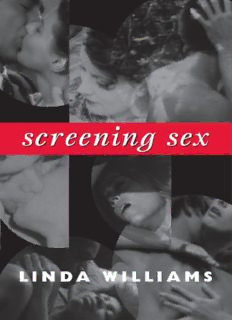
Screening Sex PDF
Preview Screening Sex
Screening Sex a john hope franklin center book linda williams Screening Sex duke university press Durham and London 2008 © 2008 Duke University Press All rights reserved. Printed in China on acid-free paper ♾ Typeset in Warnock Pro Light by Tseng Information Systems, Inc. Library of Congress Cataloging-in-Publication Data appear on the last printed page of this book. To Paul contents Acknowledgments ix Introduction to Screening Sex 1 1 Of Kisses and Ellipses: The Long Adolescence of American Movies (1896–1963) 25 2 Going All the Way: Carnal Knowledge on American Screens (1961–1971) 68 3 Going Further: Last Tango in Paris, Deep Throat, and Boys in the Sand (1971–1972) 112 4 Make Love, Not War: Jane Fonda Comes Home (1968–1978) 155 5 Hard-Core Eroticism: In the Realm of the Senses (1976) 181 6 Primal Scenes on American Screens (1986–2005) 216 7 Philosophy in the Bedroom: Hard-Core Art Film since the 1990s 258 Conclusion: Now Playing on a Small Screen near You! 299 Notes 327 Bibliography 379 Index 397 acknowledgments This book began as an amateur movie. In the mid-1990s I bought a video camera and amused myself by asking friends and colleagues—mostly people who knew and cared about film—to tell me about the most erotic moments they had en- countered at the movies. Most people’s answers connected to an earlier moment in their life, a moment in which they made a discovery, through movies, of a “realm of the senses” that they may or may not have already known. Some an- swers were long and complex, some short and simple, but they all revealed the role movies have played in our sexual coming of age and development, and they all demonstrated that screening sex was both a revelation and a concealment. I never finished my amateur movie. It was just a lark—an escape from seemingly more pressing projects. But the fact that, camera in hand, I could think of no more important question to ask than when and how movies had first turned us on eventually made me realize that the rather intimate question I had asked so many others was perhaps one worth asking myself. This book is my more scholarly and system- atic, though no less personal and idiosyncratic, answer. I thank all my initial interlocutors, those on camera and
Description: